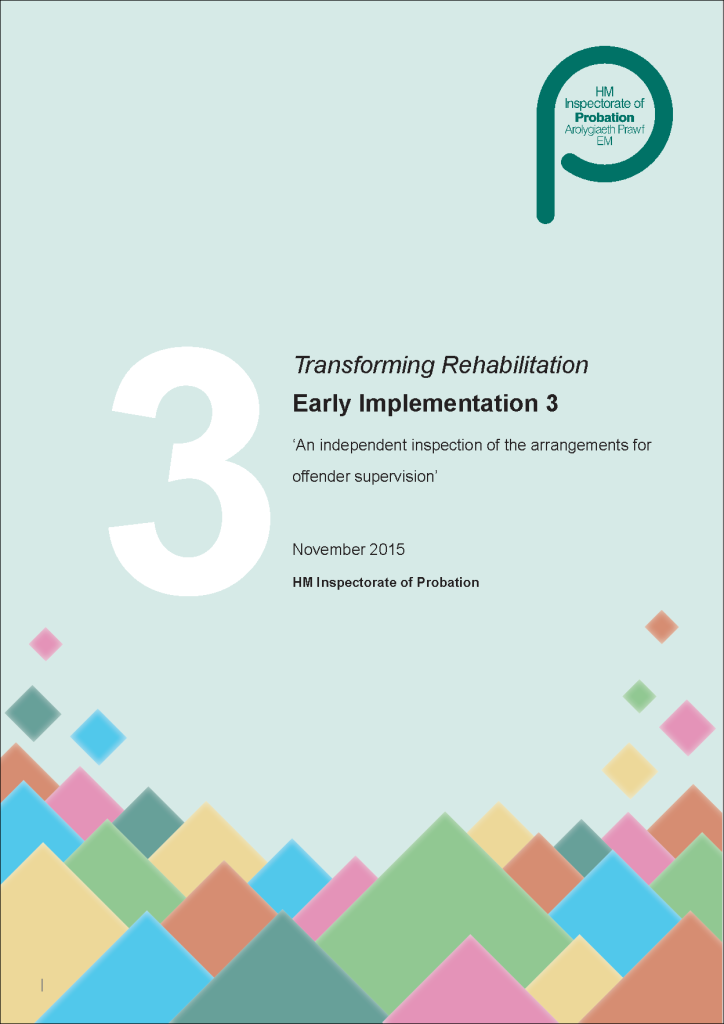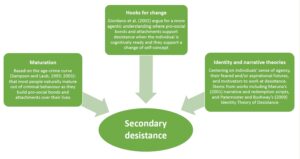HM Inspectorate of Probation yesterday (10 November 2015) published its third inspection report on the early implementation of the new split probation system.
This inspection focuses on work undertaken at the point of sentence and allocation by the National Probation Service (NPS), work undertaken by the Community Rehabilitation Companies (CRCs) and the NPS to manage offenders, and the interfaces between the two organisations in respect of enforcement and risk review.
It is based on inspections of six NPS LDU clusters and the associated CRCs and looked at 45 NPS cases and 120 cases allocated to CRCs and the work undertaken on them between November 2014 and March 2015 .
Findings
The inspectors’ findings are organised under five headings:
- Assisting sentence and the assignment of cases
- Early work in the CRCs
- Early work in the NPS
- Enforcement
- Risk escalation
I summarise the inspectors’ findings under each section in turn below.
[divider]
Assisting sentence and the assignment of cases
Inspectors found that communication between the NPS and CRCs was improving; there appeared to be better liaison around the flow of information relating to pre-sentence work.
However, there was little discussion between the different probation organisations over appropriate proposals for reports and still too many cases without a sufficient Risk of Serious Harm screening. A Risk of Serious Recidivism score was almost always calculated, but was sometimes inaccurate.
Most worryingly, the Case Allocation System had been completed in less than two thirds of cases.
The inspectors noted that there had been a marked shift towards group induction, particularly within CRCs. Although this was unpopular with a number of offender managers (who felt the individual inductions resulted in better engagement), inspectors found no evidence to suggest that individual induction was in fact more effective than group induction.
[divider]
Early work in the CRCs
The inspectors flagged up a number of causes for concern:
- Although most cases were assigned to an identified offender manager within one working day after sentence, fewer than half the cases inspected had their first appointment within five working days.
- Full information for new cases was often not available at, or immediately following, allocation.
- The OASys likelihood of reoffending assessment was sufficient in only just over half of cases.
- Sentence plans were not always completed in good time, and did not always address factors relating to offending, wider diversity issues and barriers to engagement.
- Many offenders supervised by CRCs had committed violent offences or been involved in domestic abuse. Inspectors found concerns about protecting children in a number of cases – only two thirds of Risk of Serious Harm screenings and half a full risk of harm analyses were of an adequate standard. An effective risk management plan was in place in less than half of all relevant cases.
More positive findings were that appointments were roughly in line with sentence requirements and staff had made efforts to motivate offenders to comply. Non-compliance was addressed quickly and appropriately.
[divider]
Early work in the NPS
Inspectors noted some positive aspects of NPS work:
- Almost all cases were allocated within one working day and seen by their offender managers within two days.
- Diversity issues and barriers to engagement were identified in the majority of cases (although plans to address these issues only developed two thirds of the time).
- Most cases had a sufficient assessment of the likelihood of reoffending (though this was not always completed on time).
- Sentence plans were sufficient in two thirds of cases.
- The frequency and type of contact was good in most cases, and in the majority interventions had been delivered as planned.
- There was a robust and appropriate response to non-compliance.
However, inspectors again highlighted their concerns around issues of risk:
- Risk of Serious Harm screenings took too long to complete.
- Full risk of harm assessments were sufficient in only just over half the cases inspected.
- The analysis of risk to children was not good enough in too many cases.
- Less than two thirds of risk management plans were sufficient.
- The use of child protection procedures needed to improve and management oversight had not been effective enough.
[divider]
Enforcement
The inspectors found that enforcement processes varied considerably with some Local Delivery Units still experiencing high rejection rates for breach packs. Many had been returned for spelling and grammatical errors or to question proposals. Unsurprinsingly, best practice was found in areas that had established good quality assurance processes and positive relationships between CRC staff and NPS prosecution staff.
Inspectors did find that the small number of licence cases in the sample were enforced correctly by CRCs and recalls were appropriate.
[divider]
Risk escalation
Risk escalation was an area in which inspectors were more satisfied with the way in which practice and procedures were improving. They found that staff confidence had grown and there was a greater investment in the value of the process in most areas. In almost all inspected cases there was a clear and justifiable reason for starting the escalation procedure.
Inspectors did, however, find that the effectiveness of local processes varied considerably between areas.
[divider]
Conclusion
The Inspectors’ overall conclusion reflects their continuing concerns about the new system; particularly around risk, and, most seriously, around risk to children:
Within the National Probation Service we have found inconsistent application of the Risk of Serious Recidivism tool which is leading to mistakes in allocation. The variable quality of risk of harm assessments is a continuing concern. Within Community Rehabilitation Companies we have found inconsistent standards in relation to risk of harm assessment, likelihood of reoffending assessment and recording of escalation and breach processes.
On the positive side, use of Multi-Agency Public Protection Arrangements and restrictive requirements is good and risk escalation processes between CRCs and the NPS have improved.
Staff in CRCs and the NPS feel under workload pressures but the offenders we spoke to have noticed little change and are generally happy with the service they received.
So far, inspectors have focused very much on the new processes and procedures necessitated by splitting the probation service into two parts. From April 2016, HMI Probation will be introducing their new Quality & Impact inspection programme which will also look at the impact on offenders of the work that NPS and CRCs undertake.
We may then finally get a proper sense of whether the new system has bedded down and helps reduce reoffending.
Currently, signs are not promising.










3 Responses
This is an interesting early report. It is quite evident there is turmoil within CRC particularly following release.
My Project worked on the Gateways *Early Adoption Scheme* rolled out in the NW a year before the split of Probation.
Given the stability affordable accommodation contributes to a newly – released prisoner, I am astonished at how the accommodation needs of people coming from custody have been so glibly washed aside.
In September 2014, within three days of opening, two referrals were made for accommodation needs. These two referrals were not on Gateways, as it was a voluntary pathway offered as part of resettlement packages. Both had refused to opt in which is fair enough. It was known the two women needed secure accommodation.
Then the onslaught started. Referrals came as a name, release date and a couple of sentences, for example, *he’s really engaged well & is keen to continue addressing his drug issues in the community* All of this was done via email. Despite repeated requests to complete referral forms.
Some of our accommodation is shared. As a two – tier service, most of our referrals will move into shared accommodation homes as our risk management and assessment tools are activated.
The long & short is. In a year, we have had people brought and left in our car park, with a food parcel from the local foodbank and their prison bag. Usually on a Friday, which left us with a person we knew very little about for 72 hours. In properties, with other people, in communities with elderly people, families of hard workers and the young.
On the upside, NPS has been quite a joy to work with. Prison visits arranged prior to release, full information, well organised MAPPA meetings and NPS asking and listening to us on housing elements & where our support fits into the jigsaw.
Our data for our first year has shown an interesting audit trail of each person’s journey under our scheme. The report will be published following evaluation by an independent body. I know the results. I can see the patterns of longer term residents under our scheme I can see the utter chaos at the start of each journey back into the community.
My experience of the last year has opened my eyes to a raft of poorly delivered practices, an astounding lack of knowledge of accommodation needs of people, by far, the words, *I need an address for a service – user being released in three days* told me everything.
Our service offers homes. On a housing first model. It was with sheer determination on our part that we got through a first year. However, the biggest shock to me is the *cattling* of people coming back to the community.
I’ll be reading this report thoroughly.
Thanks, Russell as always..
Thanks Tracey.
It’s invaluable to have some first hand feedback of how things are in reality.
As always, there is quite a time lag with inspection reports since they have to look backwards to examine cases and then time to prepare and publish the reports.
Even though this report is very critical, it is still looking at very early days of TR and doesn’t really cover the time that new providers took over in February 2015.
I know many of us are apprehensive about what the inspectors find next year.
How can CRCs have the impact required/desired when the role requires 1500 staff and the providers have employed 500 (please allow for ‘poetic’ license as: I don’t know how many employees they have, I simply know that it’s not enough to make a difference) and the devices being used to achieve the change are not those that will attain the desired effect. Offenders want Houses and Jobs, and are being offered, education and training, then extended periods of volunteering, before they can attain one of the poorly paid roles on offer to them in/by the sector.
A case of the gormless leading the ignorant: or shall we keep calling it ‘Transforming Rehabilitation?’